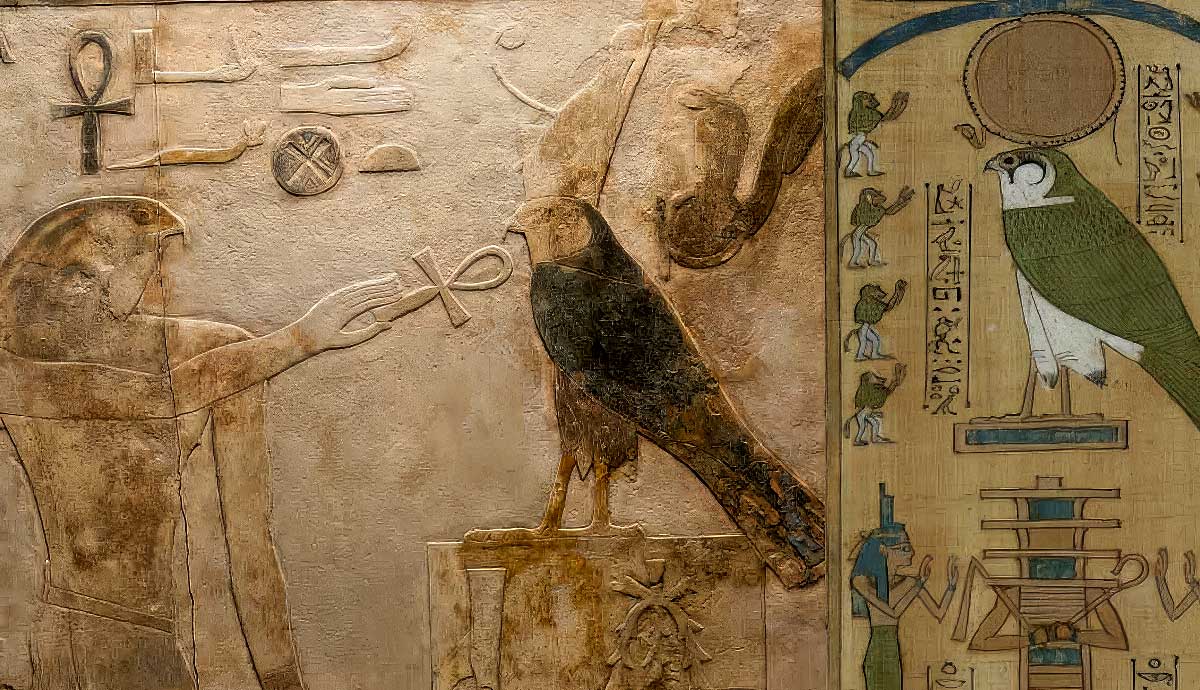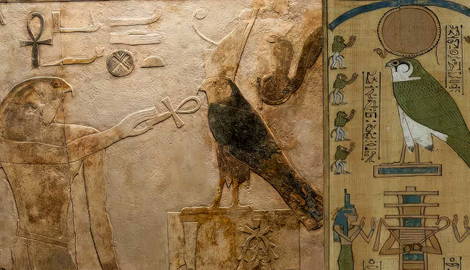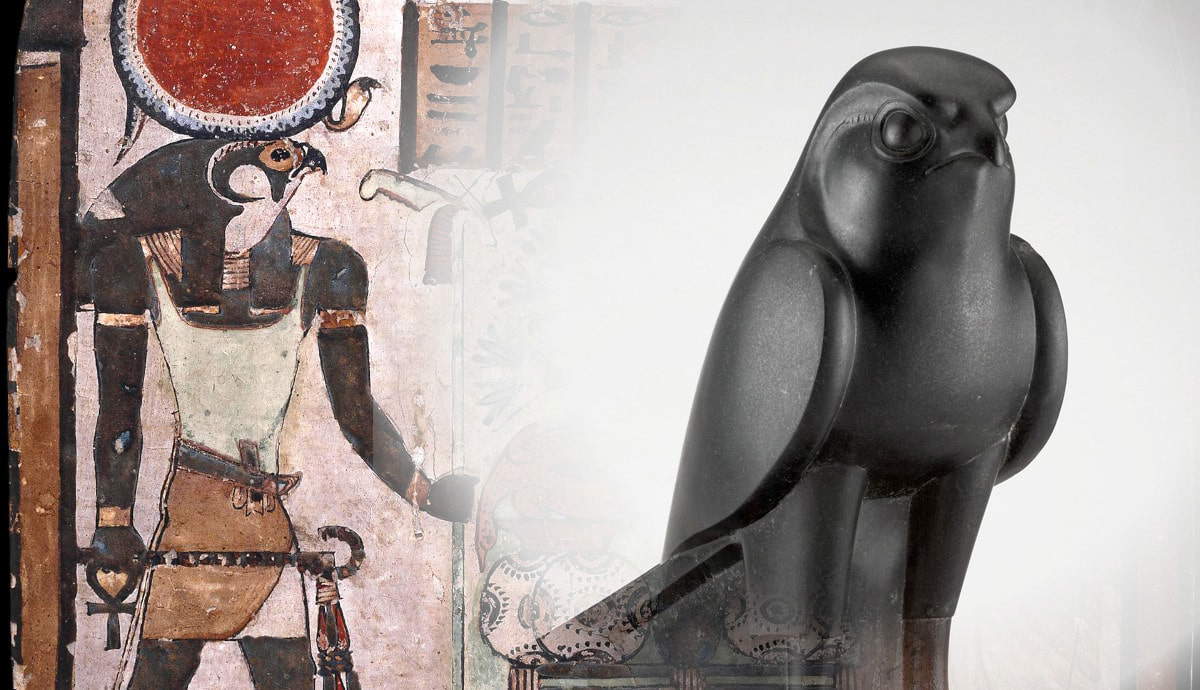
The world of Egyptian gods was not a peaceful one. Revenge, enmity, and rebellion were part of their daily (after)life. One such rebellion broke off during the 363rd year of Ra-Horakhty’s rule, in Nubia. After assembling an army of gods, which included the mighty Horus of Behdet, Ra-Horakhty managed to defeat the rebels and decapitate their instigator, Seth. However, this did little to deter him and the rebels. Read on to find out how this brutal combat ended and why, after the battle, every new temple in Egypt needed to bear the winged sun emblem over the front door.
Egyptian Winged Sun: How Does It Relate to Horus of Behdet and Seth?

The winged sun disc, a symbol that was born in the Egyptian Old Kingdom as one particular form of Horus of Behdet (himself a particular form of the falcon god Horus), was a common motive in Egyptian art. However, the tale that explains how it came to be, comes from two thousand years after the Old Kingdom. The emblem is composed of a central sun disc, usually with two uraeus cobras coming out of it and symmetrical wings extending to the sides. Symmetry and dualism represent two of the most important principles both in Egyptian art and thought, as Egypt itself was sometimes called ‘The Two Lands’, Upper (Southern) Egypt and Lower (Northern) Egypt. The sun disc was the most important symbol for the solar cults that started to appear in the Predynastic Period and soon gained relevance.
The winged sun was intended to protect the land of Egypt, but most importantly, its pharaoh, and thus it appeared mostly in royal architecture and art. It was also featured in every temple of Egypt, usually as a relief at the top of the entry passages and doors, and in some royal and non-royal tombs as well. Although in Egypt, it was an emblem of the sun god Ra, the kingly aspects of the winged sun made it popular in other cultures too, and it has been found in monuments of Assyria, Persia, Israel, and the Kingdom of the Hittites.
Horus of Behdet and the Temple of Horus at Edfu

The tale of the winged sun is told as part of the greater Horus Myth, a long cosmological text engraved in the outer and inner walls of the Ptolemaic Temple of Horus at Edfu. The engravings are beautifully illustrated by reliefs and tableaux that show the most important scenes of the myth, including the struggle between Horus of Behdet and Seth. It is important to mention that Horus Behdetite, or Horus of Behdet, is in principle a unique god and not to be confused (again, in principle) with Horus, the falcon god who is present in Egyptian religion since its inception. Behdet is the ancient name of Edfu, a city that gained prominence in the Late Period and consequently had its own version of Horus.
The Temple of Horus at Edfu is without a doubt the best-preserved temple of all Egypt, and it was built over a period of 150 years, through several different phases. Ptolemy III Euergetes personally conducted the foundation rituals for the Temple of Edfu on August 23, 237 BCE. But it was only 90 years later, during the reign of Ptolemy VIII Euergetes II, that the Temple was formally inaugurated. Both Ptolemy and Cleopatra attended the ceremony. Modifications continued until the end of the Ptolemaic Period, the last additions made in 70 BCE when the outer rock rampart was completed and decorated.
Ra-Horakhty vs. The Rebels

The text itself begins by describing a rebellion, which was not an uncommon occurrence in ancient Egypt. It was, precisely, during the 363rd year of the reign of Ra-Horakhty (Ra-Horus-of-the-horizon, a late blending of Horus and Ra). While he was stationed in the South (Nubia) along with his army, a group of rebels started to plot against the god-king. It was his son and helper, Horus of Behdet, who first learned about the plot. Angry at the insurgents, he proposed a swift and strong retaliation. His father agreed, and so both of them embarked upriver to squash the rebellion with all their might. Horus of Behdet exclaimed, ‘May the uraeus serpent prevail before them!’ before sending his magic to destroy the rebels.
The uraeus was a symbol of kingship, and a powerful weapon when order in Egypt was disrupted. So powerful, that the text describes in detail how it managed to defeat the rebels. It is said in the myth that the uraeus had the power to get inside the enemies’ minds, forcing them to kill each other.
Horus of Behdet, angry at the people who dared question Ra-Horakhty’s rule, transformed himself into a bloodthirsty beast, who was able to disembowel enemies with his claws. Later, he is said to have flown to the skies as a great winged solar disc, wearing the uraeus emblem at the center of the disc. In this form, he attacked the enemies with such might that, according to the temple text, ‘they could no longer see with their eyes, nor hear with their ears’. The massacre lasted mere seconds. There were no survivors in Nubia. Once the rebels were finished with, Horus of Behdet as a winged sun returned to the barque of Ra-Horakhty, who was highly pleased with his actions.
Ra-Horakhty Prevails

The rebellion was crushed in Nubia, but in Egypt, there were many agitators still alive and plotting against Ra. When they heard the news of Nubia, they transformed themselves into crocodiles and hippopotamuses and attacked the boat of Horus and Ra as it was passing downriver. But Horus of Behdet’s might was such, in the form of the great winged sun, that the rebels were unable to harm Ra or his boat, and were ultimately crushed. Defeated, the ones that were still alive fled to Upper Egypt to find reinforcements. It is said in the text that Horus of Behdet, shining like a winged sun in the prow of a huge boat sailing northwards the Nile, speared each and every one of the rebels in the form of hippopotamuses, and then fed the carcasses to his companions.
At one point, the rebels reach a town in Upper Egypt named Meret, and then the name of Seth is first mentioned in the text. It appears that he had been the instigator since the beginning, and the rebels looked to him for instructions on how to proceed and for protection. Seth was one of the most powerful gods in ancient Egypt, as well as one of the oldest and most fierce. His actions were always chaotic, often unexpected. Also, he had a history of enmity with Ra and Horus.
Ra-Horakhty sailed his barque up to a branch of the Nile close to the town of Meret, where he, Horus of Behdet and their whole army disembarked. A blood bath ensued, and 381 enemies were captured and brought back to the barque of Ra, where each one of them was beheaded.
Horus vs. Seth

But the war was far from over. Seth was not happy with his soldiers being killed in cold blood. He roared, and the sound of his voice reached every corner of the Two Lands. Even Ra-Horakhty stopped what he was doing at the moment (beheading enemies) and asked ‘What is that? Are those the cries of Seth, over what is happening to his army?’. Then, Seth attacked. The battle was long and cruel, but ultimately Ra-Horakhty prevailed and Seth and his company were brought to him so that he could decide what to do.
The first thing that Ra did was take a wooden club and smash Seth’s mouth so that he could not talk anymore. Then he instructed the god of scribes, Thoth, to rename some of the locations. The town of Meret was rebranded The-Place-Of-The-Roar, and the palace which was to be built in honor of Horus of Behdet would be called The-Place-Of-Purity. Finally, Ra-Horakhty allowed the goddess Isis and his son Horus (a different Horus, not Horus of Behdet) to do with the enemies as they wished. They chose to decapitate them.
The Aftermath

Horus, son of Isis, cut the head of the chiefs of the revolt before the eyes of Ra and the whole Ennead of gods. After that, he dragged Seth by the feet into a sacred chamber and speared him in the head and in the back. Thoth took note of this, naming the place The-Place-Of-The-Dragged-One. Isis, admiring the great powers of Horus of Behdet, asked him to personally protect her son Horus. He agrees, and from this moment on, both gods are referred to as one god.
Despite having been beheaded and speared, Seth was not dead. He took the form of a reptile and sunk underground, effectively escaping the other gods. Horus then transforms himself into an inanimate object, which in the text is mentioned as a ‘protective spear’, to prevent Seth from doing any more harm. With Seth out of the picture, it was easier for Horus/Horus of Behdet and Ra-Horakhty to kill the remaining rebels.
Ra and Horus After the Battle

Ra said to Thoth: ‘Behold, Horus Behdetite is a warrior who kills his foreign enemies daily’, to which Thoth replied that for this reason the priest of Horus would be called ‘warrior’ from that moment on. The goddess Isis is then commended for her powerful magic, and her priestesses were similarly awarded a new name. Finally, it is decided that the palaces, after the expulsion of the rebels from the land of Egypt, would be called ‘happy places’.

The text mentions that Horus of Behdet continued to patrol the land of Egypt. In the deserts, Horus took the form of a huge lion with a human face. And in the Nile Valley, he took the form of the winged sun. This form was so powerful that it is said in the text that his enemies die out of fear in his presence. As a hommage to Horus, Ra-Horakhty said to Thoth: ‘You will make this winged-sun in every sanctuary where I have ever rested, in the sanctuaries to the gods of Upper Egypt and in the sanctuaries of the Lower Egypt’. And so, Thoth made sure that every ‘happy place’ and every temple in Egypt bore the winged sun emblem over its doors.










